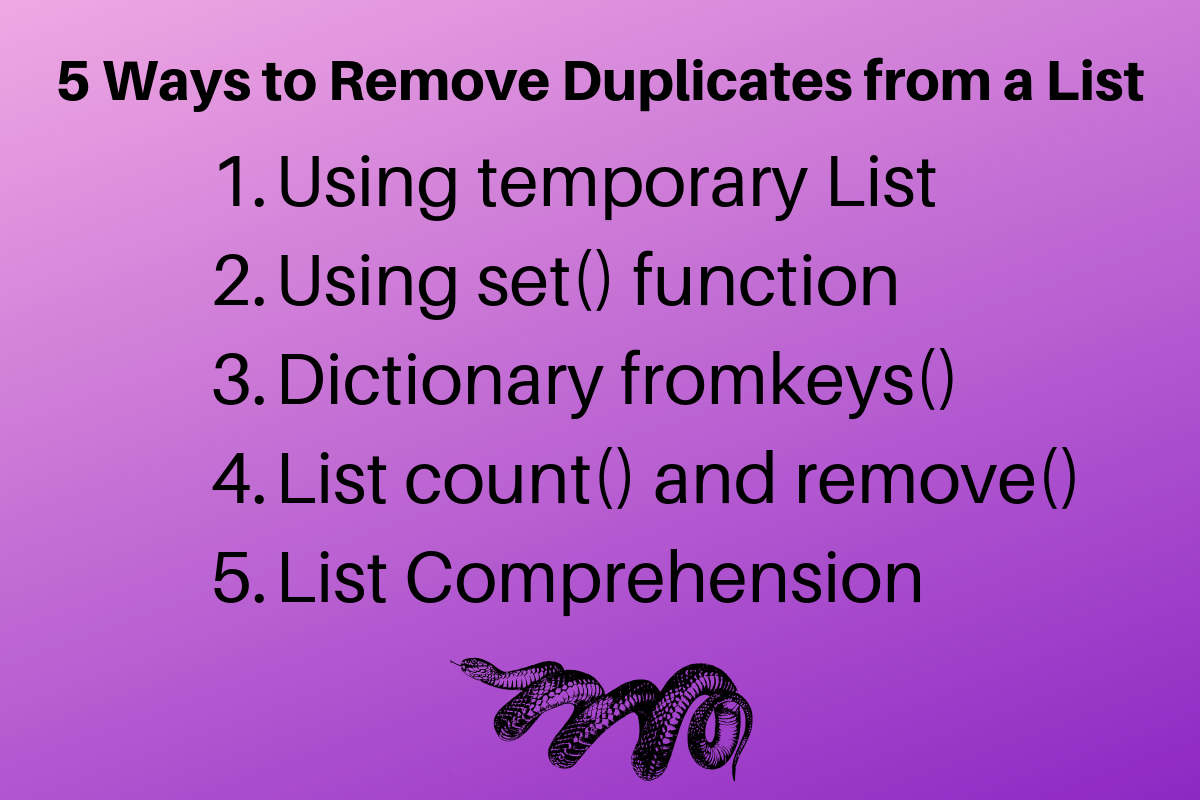- Log in to:
- Community
- DigitalOcean
- Sign up for:
- Community
- DigitalOcean

There are many ways to remove duplicates from a Python List.
- Using a temporary List and Looping
- Using set() built-in method
- Using Dictionary Keys
- List count() function
- List Comprehension
Removing Duplicates from a List
Python list can contain duplicate elements. Let’s look into examples of removing the duplicate elements in different ways.
1. Using Temporary List
This is the brute-force way to remove duplicate elements from a list. We will create a temporary list and append elements to it only if it’s not present.
ints_list = [1, 2, 3, 4, 3, 2]
temp = []
for x in ints_list:
if x not in temp:
temp.append(x)
ints_list = temp
print(f'Updated List after removing duplicates = {temp}')
Output: Updated List after removing duplicates = [1, 2, 3, 4] Recommended Reading: Python f-strings
2. set() function
Python set doesn’t have duplicate elements. We can use the built-in set() function to convert the list to a set, then use the list() function to convert it back to the list.
ints_list = [1, 2, 3, 4, 3, 2]
ints_list1 = list(set(ints_list))
print(ints_list1) # [1, 2, 3, 4]
3. List elements as Dictionary Keys
We know that dictionary keys are unique. The dict class has fromkeys() function that accepts an iterable to create the dictionary with keys from the iterable.
ints_list = [1, 2, 3, 4, 3, 2]
ints_list2 = list(dict.fromkeys(ints_list))
print(ints_list2) # [1, 2, 3, 4]
4. List count() function - not recommended
The list count() method returns the number of occurrences of the value. We can use it with the remove() method to eliminate the duplicate elements from the list.
ints_list = [1, 2, 3, 4, 3, 2]
for x in ints_list:
if ints_list.count(x) > 1:
ints_list.remove(x)
print(ints_list) # [1, 2, 3, 4]
NOTE: As pointed out in the below comment, using the count() function is not advisable while removing the element from the same iterator because it can lead to unwanted results. For example:
values = [87, 94, 45, 94, 94, 41, 65, 94, 41, 99, 94, 94, 94]
for x in values:
if values.count(x) > 1:
values.remove(x)
print(values) # [87, 45, 65, 41, 99, 94, 94] - 94 is still present twice
5. List Comprehension
We can create a list from an iterable using the list comprehension. This technique is the same as using the temporary list and the for loop to remove the duplicate elements. But, it reduces the number of lines of the code.
int_list = [1, 2, 3, 4, 3, 2]
temp = []
[temp.append(x) for x in ints_list if x not in temp]
print(temp) # [1, 2, 3, 4]
Best Way to Remove Duplicates from a List
If you don’t want duplicate elements, you should use Set. But, if you have to remove the duplicate values from a list, then I would prefer count() function because it doesn’t create another temporary set or list object. So, it’s more memory efficient.
Thanks for learning with the DigitalOcean Community. Check out our offerings for compute, storage, networking, and managed databases.
About the author
Java and Python Developer for 20+ years, Open Source Enthusiast, Founder of https://www.askpython.com/, https://www.linuxfordevices.com/, and JournalDev.com (acquired by DigitalOcean). Passionate about writing technical articles and sharing knowledge with others. Love Java, Python, Unix and related technologies. Follow my X @PankajWebDev
Still looking for an answer?
how can i remove duplicate from a list without using a for loop or while loop or any in-build function in python do’not use list comprehension as well.
- Rajeev
ints_list = [1,1,1,1] for x in ints_list: if ints_list.count(x) > 1: ints_list.remove(x) print(ints_list) # Output: [1,1]
- chirag maliwal
how can i remove duplicates using two for loop by comparing the list member and if match occur then simply remove the particular element
- RANA SIDHDHARAJSINH SAHDEVSINH
The count() method should never be used. The reason is you should never try to remove an element from a list while iterating on the list itself. The system may behave unexpectedly and skip over a particular item from the list as the list is constantly changing while the loop runs. Try the count() method on following list: values = [87, 94, 45, 94, 94, 41, 65, 94, 41, 99, 94, 94, 94] You’ll notice that the value 94 still stays in the final outcome. The best way is to use set method.
- Meet
values = [87, 94, 45, 94, 94, 41, 65, 94, 41, 99, 94, 94, 94] def removeDuplicate(z): for i in z: if z.count(i)>1: z.remove(i) removeDuplicate(z) return z print(removeDuplicate(values)) ************Output************** [87, 45, 65, 41, 99, 94]
- vikram ram raut
Deploy on DigitalOcean
Click below to sign up for DigitalOcean's virtual machines, Databases, and AIML products.
Become a contributor for community
Get paid to write technical tutorials and select a tech-focused charity to receive a matching donation.
DigitalOcean Documentation
Full documentation for every DigitalOcean product.
Resources for startups and SMBs
The Wave has everything you need to know about building a business, from raising funding to marketing your product.
Get our newsletter
Stay up to date by signing up for DigitalOcean’s Infrastructure as a Newsletter.
New accounts only. By submitting your email you agree to our Privacy Policy
The developer cloud
Scale up as you grow — whether you're running one virtual machine or ten thousand.
Get started for free
Sign up and get $200 in credit for your first 60 days with DigitalOcean.*
*This promotional offer applies to new accounts only.
